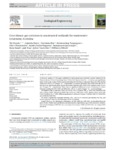Por favor, use este identificador para citar o enlazar este ítem:
http://www.alice.cnptia.embrapa.br/alice/handle/doc/979194Registro completo de metadatos
| Campo DC | Valor | Lengua/Idioma |
|---|---|---|
| dc.contributor.author | MANDER, U. | pt_BR |
| dc.contributor.author | DOTRO, G. | pt_BR |
| dc.contributor.author | EBIE, Y | pt_BR |
| dc.contributor.author | TOWPRAYOON, S. | pt_BR |
| dc.contributor.author | CHIEMCHAISRI, C. | pt_BR |
| dc.contributor.author | NOGUEIRA, S. F. | pt_BR |
| dc.contributor.author | JAMSRANJAV, B. | pt_BR |
| dc.contributor.author | KASAK, K. | pt_BR |
| dc.contributor.author | TRUU, J. | pt_BR |
| dc.contributor.author | TOURNEBIZE, J. | pt_BR |
| dc.contributor.author | MITSCH, W. J. | pt_BR |
| dc.date.accessioned | 2014-02-07T11:11:11Z | pt_BR |
| dc.date.available | 2014-02-07T11:11:11Z | pt_BR |
| dc.date.created | 2014-02-07 | pt_BR |
| dc.date.issued | 2014 | pt_BR |
| dc.identifier.citation | Ecological Engineering, v. 64, p. 1-17, 2014. | pt_BR |
| dc.identifier.uri | http://www.alice.cnptia.embrapa.br/alice/handle/doc/979194 | pt_BR |
| dc.description | A literature analysis of 158 papers published in international peer-reviewed journals indexed by the Thomson Reuters Web of Knowledge from 1994 to 2013 showed that CO2C emission was significantly lower in free water surface (FWS) constructed wetlands (CW) than in subsurface flow (SF) CWs (median values from 95.8 to 137.0 mg m−2h−1, respectively). In vertical subsurface flow (VSSF) CWs the CH4Cemission was significantly lower than in horizontal subsurface flow (HSSF) CWs (median values 3.0, 6.4,and 4.0 mg m−2h−1, respectively). There were no significant differences in N2O N emission in various Cw types (median for FWS, VSSF and HSSF CWs: 0.09, 0.12, and 0.13 mg m−2h−1correspondingly).The highest value of emission factor (EF) of CH4((CH4C/inflow TOCin) * 100%) was found for FWSCWs (median 18.0%), followed by HSSF CWs (3.8%), and VSSF CWs (1.28%). Median values of N2O EFs((N2O N/inflow TNin) * 100%) differed significantly in all three CW types: 0.34% for HSSF, 0.11% for FWS,and 0.018% for VSSF CWs.We found a significant correlation between TOCin and CH4C emission and between the TNinandN2O N emission values for all of the types of CWs we studied.Hybrid CWs (e.g., the subsequent combination of VSSF, HSSF and FWS CWs) are beneficial from thepoint of view of both water purification and minimization of greenhouse gas (GHG) emissions. Likewise,intermittent loading in VSSF CWs and macrophyte harvesting in HSSF and FWS CWs can mitigate GH Gemissions. | pt_BR |
| dc.language.iso | eng | eng |
| dc.rights | openAccess | eng |
| dc.subject | Intermittent loading | pt_BR |
| dc.subject | Pulsing hydrology | pt_BR |
| dc.title | Greenhouse gas emission in constructed wetlands for wastewater treatment: a review. | pt_BR |
| dc.type | Artigo de periódico | pt_BR |
| dc.date.updated | 2014-09-23T11:11:11Z | pt_BR |
| dc.subject.thesagro | Dióxido de Carbono | pt_BR |
| dc.subject.thesagro | Metano | pt_BR |
| dc.subject.nalthesaurus | Carbon dioxide | pt_BR |
| dc.subject.nalthesaurus | Methane | pt_BR |
| dc.subject.nalthesaurus | Nitrous oxide | pt_BR |
| riaa.ainfo.id | 979194 | pt_BR |
| riaa.ainfo.lastupdate | 2014-09-23 | pt_BR |
| dc.identifier.doi | http://dx.doi.org/10.1016/j.ecoleng.2013.12.006 | pt_BR |
| dc.contributor.institution | ULO MANDER, UNIVERSITY OR TARTU; GABRIELA DOTRO, CRANFIELD UNIVERSITY; YOSHITAKE EBIE, NATIONAL INSTITUTE FOR ENVIRONMENTAL STUDIES; SIRINTORNTHEP TOWPRAYOON, KING MONGKUT'S UNIVERSITY OF TECHNOLOGY; CHART CHIEMCHAISRI, KASETSART UNIVERSITY; SANDRA FURLAN NOGUEIRA, CNPM; BAASANSUREN JAMSRANJAV, INSTITUTE FOR GLOBAL ENVIRONMENTAL STRATEGIES; KUNO KASAK, UNIVERSITY OF TARTU; JAAK TRUU, UNIVERSITY OF TARTU; JULIEN TOURNEBIZE, NATIONAL RESEARCH INSTITUTE OF SCIENCE AND TECHNOLOGY FOR ENVIRONMENT AND AGICULTURE; WILLIAM J. MITSCH, FLORIDA GULF COAST UNIVERSITY. | pt_BR |
| Aparece en las colecciones: | Artigo em periódico indexado (CNPM)  | |
Ficheros en este ítem:
| Fichero | Descripción | Tamaño | Formato | |
|---|---|---|---|---|
| Manderetal2014EcolEngonGHGsinCWsONLINE.pdf | 1,19 MB | Adobe PDF |  Visualizar/Abrir |









